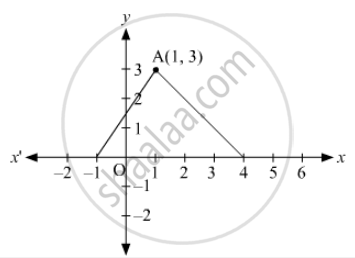Advertisements
Advertisements
प्रश्न
Seg AB is parallel to X-axis and coordinates of the point A are (1, 3), then the coordinates of the point B can be ______.
पर्याय
(–3, 1)
(5, 1)
(3, 0)
(–5, 3)
उत्तर
Seg AB is parallel to X-axis and coordinates of the point A are (1, 3), then the coordinates of the point B can be (–5, 3).
APPEARS IN
संबंधित प्रश्न
On which axis do the following points lie?
Q(0, -2)
In what ratio is the line segment joining (-3, -1) and (-8, -9) divided at the point (-5, -21/5)?
If the points p (x , y) is point equidistant from the points A (5,1)and B ( -1,5) , Prove that 3x=2y
If the point C ( - 2,3) is equidistant form the points A (3, -1) and Bx (x ,8) , find the value of x. Also, find the distance between BC
Find the value of a, so that the point ( 3,a ) lies on the line represented by 2x - 3y =5 .
Find the ratio in which the point (−3, k) divides the line-segment joining the points (−5, −4) and (−2, 3). Also find the value of k ?
The perpendicular distance of the P (4,3) from y-axis is
The area of the triangle formed by the points P (0, 1), Q (0, 5) and R (3, 4) is
If A(−3, 5), B(−2, −7), C(1, −8) and D(6, 3) are the vertices of a quadrilateral ABCD, find its area.
What is the area of the triangle formed by the points O (0, 0), A (6, 0) and B (0, 4)?
Find the area of triangle with vertices ( a, b+c) , (b, c+a) and (c, a+b).
The ratio in which the line segment joining points A (a1, b1) and B (a2, b2) is divided by y-axis is
In Fig. 14.46, the area of ΔABC (in square units) is

Point (0, –7) lies ______.
Abscissa of all the points on the x-axis is ______.
The coordinates of a point whose ordinate is `-1/2` and abscissa is 1 are `-1/2, 1`.
If the points P(1, 2), Q(0, 0) and R(x, y) are collinear, then find the relation between x and y.
Given points are P(1, 2), Q(0, 0) and R(x, y).
The given points are collinear, so the area of the triangle formed by them is `square`.
∴ `1/2 |x_1(y_2 - y_3) + x_2(y_3 - y_1) + x_3(y_1 - y_2)| = square`
`1/2 |1(square) + 0(square) + x(square)| = square`
`square + square + square` = 0
`square + square` = 0
`square = square`
Hence, the relation between x and y is `square`.
The coordinates of two points are P(4, 5) and Q(–1, 6). Find the difference between their abscissas.
The distance of the point (–6, 8) from x-axis is ______.
